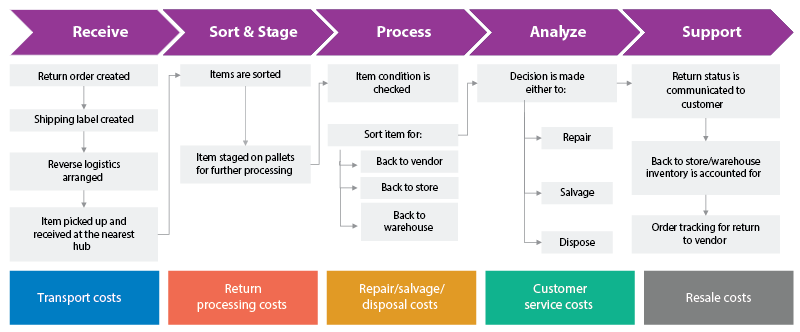Insights
- Returns is the double-edged sword that has now become an integral part of retailing.
- Retailers need to invest in building a robust returns management strategy to make sure that the sword does not wreck their profits and their customer base.
- Streamlining the process is the key to effectively managing returns.
- An integrated logistics ecosystem can help retailers distribute return volume appropriately and in the most cost-effective way.
- Automation of handling processes at the processing centers can help reduce costs. Use of proper return labels can reduce errors and delivery delays, while integration of the third-party carriers would provide visibility into logistics.
- Availability of shipping movement and tracking information across all departments can help in planning and organizing resources.
- Outsourcing returns collection and processing to specialists in those fields could sometimes be a smarter choice than creating the infrastructure required for reverse logistics.
Returns have become an integral part of the overall customer experience, and return policies are becoming a differentiator. Easy e-commerce returns are in fact a key to repeat sales, with 92% of customers saying they would buy from that retailer again if returns are easy, according to a survey.1
The return rate in the U.S. has increased from 10.6% of total sales in 2020 to 16.6% in 2021, according to a survey by the National Retail Federation.2 However, the returns management model is still crude. It costs about 65% of the selling price to manage a product’s return. But charging for returns can be bad for business. Forty-seven percent of online shoppers in the U.S. say they will purchase elsewhere if they must pay for returns.3
It is not just the financial impact that companies have to manage. Customer complaints and negative reviews due to complicated return policies can damage the company’s reputation. Retailers need to identify ways to minimize costs and streamline processes to provide a seamless consumer experience at lower cost.
Optimizing returns management
Getting returned goods from a customer involves costs at each step — shipping services, packaging, and labels, etc. It also comes with various labor costs such as customer service, financial reconciliations, and shipping costs. If a product is returned in damaged or unsalable condition, it might have to be destroyed. If returned goods are to be sold again, they might need to be repaired or refurbished, then repackaged and remarketed.
So, retailers are exploring ways to minimize returns and increase the speed of returns so that the holding costs can be reduced.
Fewer returns
Buying from online channels is a tricky business as people cannot see and feel the physical products before making their choices. Thirty-five percent of consumers seem to return products because items do not fit or the descriptions were wrong.4 Brands and retailers need to re-evaluate their product designs, assortments, and merchandising to minimize returns. Accurate product visualizations and descriptions can help bridge the information gap. Analysis of the returns data can help identify both the patterns in why consumers are returning goods.
About 35% of products are returned due to wrong description or size
Consider the case of how Infosys supported a leading European sporting goods company in reducing its return rate using analytics. E-commerce return rates for the company were very high in Western Europe — 25%, compared to the standard of 16% for the retail fashion industry.5 Infosys helped this European company understand the behavior of habitual returners using real-time analytics and built tailored engagements for such consumers. This helped the company reduce its returns loss by 5% through understanding why some customers made repeated returns.
Faster returns
The longer a company holds the returned merchandise, the more it must spend on holding it. The value of products also goes down with time. Companies are trying to shorten the returns process so that returned products are available for resale as soon as possible, to reduce markdowns and holding costs. Companies are trying different ways to manage returns effectively. For example, the cost of handling store drop-offs, at between $1 and $5 per item, is much lower than picking up items from the customer’s home, which costs between $10 and $15. So many are incentivizing in-store drop-offs and use of smart lockers to reduce the cost and increase the speed of returns.
Figure 1. Supply chain control tower integrates information flow from different parts of the supply chain

Source: Infosys Knowledge Institute
A leading U.S.-based fashion retailer was facing challenges in managing its returns inventory. The real-time status of the returned inventory was not available as multiple systems were handling different parts of the return process. This increased the inventory holding time of returned goods and eventually reduced the price of returned goods.
Infosys helped this retailer build a dynamic inventory balancing system for store managers. This allowed the retailer to make instant decisions on returned items and update status in real time. As a result, inventory holding costs were reduced by 70% and the time taken to process a return was reduced from seven days to just one day, making the items ready for resale much faster.
Three focus areas for effective returns management
It is vital for retailers to establish comprehensive returns management programs to support their business plans. We recommend focusing on customer experience, collaboration across the ecosystem, and efficient logistics processes as the pillars of a successful returns management strategy.
Improve the customer experience
Hassle-free returns are an important part of a customer’s journey. Retailers need to devise an easy return initiation process that is simple for customers to understand and navigate. Use of chatbots for customer support and communication at each point of the return process can create a smooth user experience. Artificial intelligence (AI) chatbots have come a long way in retail, with about half of retail customers accepting AI chatbots to assist them, according to a survey.6 Availability of chatbots round-the-clock to help with basic queries is an added advantage. Building detailed customer profiles based on parameters such as a customer’s return rate, lifetime value, nature of returns made in the past, and the cause of return reported can help in analyzing returns behaviors and developing solutions to address the problems.
Creating an omnichannel approach by building a unified returns experience gives customers options to select the return method that suits them best. Sellers can collaborate with other retailers to have physical collection centers for returned items. For example, online shoppers of retailers such as Levi’s and Steve Madden in the U.S. can return products in person at Staples retail locations for an immediate refund or exchange, without a box or label.7
Collaborate to maximize value
Close collaboration is required between merchandising, store operations, e-commerce, logistics, marketing, and finance not only to reduce returns but also to maximize the value recovered. Quick decision-making about returns processing and handling using the data collected (average age of inventory, refurbishing cost, recovered value, transportation cost) at various points could ease the load on reverse logistics.
A cloud-based portal that integrates various systems can create a single source of data for everyone involved in returns. Analytics can help inform quick decisions on reselling and identify patterns in returns. It can also recommend corrective actions to avoid possible returns, help devise marketing strategies to incentivize customers to buy returned goods and optimize the markdowns on returned items to maximize value recovered. Conversational AI/chatbots can save as much as 30% on customer support costs.8
Streamline logistics
Streamlining the process is the key to effectively managing returns. An integrated logistics ecosystem can help retailers distribute return volume appropriately and in the most cost-effective way.
Automation of handling processes at the processing centers can help reduce costs. Use of proper return labels can reduce errors and delivery delays, while integration of the third-party carriers would provide visibility into logistics. Availability of shipping movement and tracking information across all departments can help in planning and organizing resources. The challenge though is that third-party carriers might be reluctant to share data. Nevertheless, outsourcing returns collection and processing to specialists in those fields could sometimes be a smarter choice than creating the infrastructure required for reverse logistics.
A major portion of returns for any brand comes from its loyal and high-value customers, who become accustomed to the returns process over time. However, if not managed well, returns can become a major pain point in the customer journey. Returns is the double-edged sword that has now become an integral part of retailing. Retailers need to invest in building a robust returns management strategy to make sure that the sword does not wreck their profits and their customer base.
References
- E-commerce product return rate – Statistics and trends, Khalid Saleh, April 11, 2022, Invespcro.
- A more than $761 billion dilemma: Retailers’ returns jump as online sales grow, Melissa Repko, January 25, 2022, CNBC.
- E-commerce product return rate – Statistics and trends, Khalid Saleh, April 11, 2022, Invespcro.
- E-commerce product return rate – Statistics and trends, Khalid Saleh, April 11, 2022, Invespcro.
- Online returns in Europe, Ecommerce news.
- 25 top chatbot statistics for 2022: Usage, demographics, trends, Matt Moran, April 12, 2022, StrartupBonsai.
- Staples partnership adds 1,000+ happy returns locations to network, Duke Ratliff, September 30, 2021, Retail Touchpoints.
- 25 top chatbot statistics for 2022: Usage, demographics, trends, Matt Moran, April 12, 2022, StrartupBonsai.





